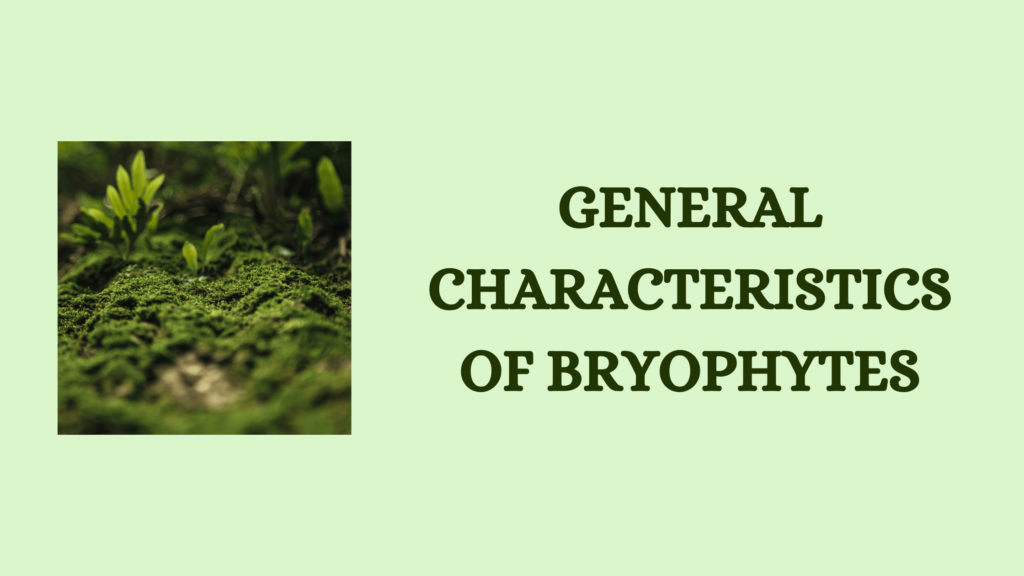Describe The Salient Features Of Bryophytes
Bryophytes are plants that lay between the aquatic and land plants. They often overlap their characteristics with algae and pteridophytes. The general characteristics of bryophytes are almost the same. However, their characteristics change with the class or type of bryophytes.
General Characteristics of Bryophytes
Habitat of Bryophytes
- Many bryophytes have amphibian habitat, Eg. Riccia, Marchantia, Cyathodium, etc.
- Riccia fluitans and Ricciocarpus natans are purely aquatic.
- Buxbaumia aphyll and Cryptothallus mirabilis are saprophytes.
- Porella platyphylla grows on rock surfaces and trees.
- Polytrichum and other mosses are xerophytes.
- Radula protensa is epiphyllous.
Morphology of Bryophytes
The plant body of bryophytes is just millimeters or up to 35 cm. Dowsonia can grow up to a length of 70 cm while Zoopsis is microscopic.
The plant body of bryophytes can be gametophytic or sporophytic, depending on the generation. Mainly, gametophytic generation is dominant while the sporophytic generation is dependent on the gametophyte.
The independent plant body is a gametophyte with rhizoids, stomata-like features, etc. They also produce certain organs or appendages for protection and conservation of moisture.
Anatomical Characteristics of Bryophytes
Anatomically, the plant body is made of parenchymatous tissues. Vascular tissues such as the xylem, phloem, and sclerenchyma are absent. However, Polytrichum consists of xylem-like cells called hydroids and phloem-like cells called leptoids for conduction. The simple parenchymatous tissues are differentiated into photosynthetic and storage regions.
The thalloid body has no differentiation into stems, leaves, roots, etc. The thalloid forms are usually green, flat, and prostate, with dorsi-ventrally or dichotomous branches. While Riccia and Marchantia have a midrib, it is absent in other species such as the Anthoceros. At the same time, Porella, Funaria, and Pogonatum have leaf-like, stem-like, and root-like organs.
Regardless of organ differentiation, all bryophytes have chloroplasts in their cells, thus autotrophic. They are fixed on soil with the use of rhizoids but they are not a separate form but an extension of the thallus. Sometimes some bryophytes have scales on their ventral surface as well.
Reproduction of Bryophytes
Bryophytes reproduce by vegetative and sexual methods. The former takes place by fragmentation of the plant body as in Riccia. Some have special vegetative propagules such as tubers, gemma cups, adventitious branches, etc.
Sexual reproduction is oogamous with a motile and small antherozoid and a non-motile and bigger female gamete. They are produced by antheridium and archegonium respectively, with a multicellular organ system and a sterile jacket for their protection.
Why are Bryophytes Called Amphibians of Plant Kingdom?
Organisms that are capable of living in both land and water are termed amphibians and they show characteristic features that enable them to survive in these conditions. Bryophytes exhibit the characteristics of land as well as aquatic plants and are hence considered the amphibians of the Plant Kingdom.
Aquatic characteristics
- Aquatic bryophytes are the types of Riccia fluitens and Ricciocarpus natans.
- Most bryophytes produce motile male gametes that can swim through the thin film of water present in the soil and reach the female gamete for fertilization.
- Bryophytes show similar characteristics of having ‘chlorophyll a’ for photosynthesis, just like green algae.
- The chlorophyll b pigment and carotenoids serve as accessory pigments.
- The storage food is also the same as algae, which is starch.
- They possess cellulose in their cell wall.
- During cell division, a cell plate is also formed in bryophytes, which makes them similar to algae.
Terrestrial characteristics
- The exposed plant body of bryophytes has a waxy layer to protect them from desiccation and water evaporation.
- Their ventilating organs include stomata or air pores.
- They have distinctive sex organs having a sterile jacket that protects them from desiccation.
- The plant body has root-like structures called rhizoids that help them with absorption.
- A conductive tissue called columella is also present in bryophytes.
- Bryophytes exhibit oogamous reproduction.
- Alternation of generation is exhibited by bryophytes.
Thus bryophytes show characteristics of both aquatic organisms such as algae and similar as well as modified characters of terrestrial plants, they are considered the amphibians of the Plant Kingdom.
Why Do The Sporophytes Remain Small In Bryophytes?
Most often, the sporophyte in bryophytes is unable to grow into an independent plantlet. The commonly considered reasons for this are as follows.
- The sporophyte is nothing but a very small sporogonium.
- It has a weak absorbing organ called the foot, with which it is completely dependent on the gametophyte for its nutrition.
- The sporophyte lacks an apical meristem and thus its apical growth suffers an early-stage growth arrest.
- It lacks branching habit due to the absence of lateral organs.
- Spore formation and maturity happen simultaneously, which does not allow the sporophyte to grow into an individual plant part.
- The sporophyte produces the capsule, foot, and seta. The capsule produces haploid non-motile spores, the foot serves as the organ of absorption and the seta holds up the capsule for the spore dispersal. Seta also enables the nutrients absorbed by the foot to pass to the capsule.
So the sporophyte of bryophytes only serves as a forerunner of the terrestrial, independent, vascular, and sporophytic plants usually produced by land plants.
References
- Bryophyta – Structure, Classification and Characteristics
- Abraham P C. Bryophytes, Pteridophytes, Gymnosperms & Paleobotany. 2000. St. Mary’s Books & Publ.
Additional Reading
- Classification of Bryophytes
- Ecological and Economic Importance of Bryophytes




